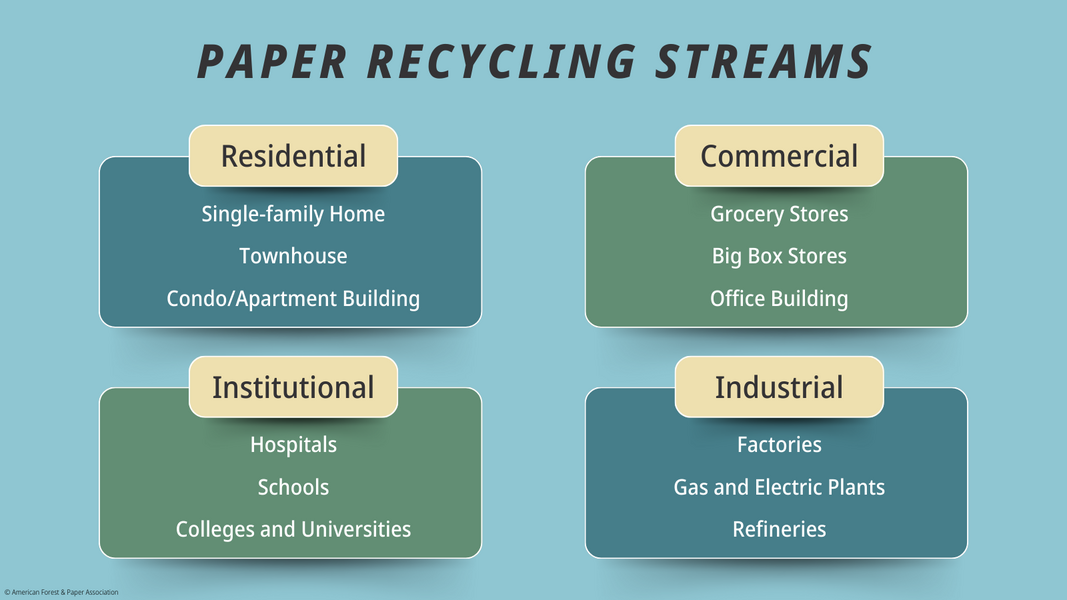What is Extended Producer Responsibility
Key Takeaways
EPR programs have brand owners, producers, and manufacturers pay to recycle or dispose of their products.
Paper is one of the most widely recycled materials in the U.S. The paper industry is working to capture even more paper from the waste stream for recycling. Paper recycling rates in the U.S. have consistently increased in recent decades.
This article covers:
- The definition of Extended Producer Responsibility
- The role of paper in EPR programs
- Our industry’s investment to improve paper recycling
- Our recommendation for EPR programs
Extended Producer Responsibility, or EPR, is the concept where brand owners, producers, and material manufacturers pay for the end-of-life costs to recycle or dispose of products they put on the market.
Types of EPR are in place in countries around the world, including in Europe and Canada. It’s also in place in the U.S. too.
Fees for producers vary based on the EPR program. Generally, fees might help cover:
- Material collection
- Waste disposal
- Technology upgrades
- Educational materials
- Program administration
- Development of recycling end-markets
Has Extended Producer Responsibility Been Implemented Before in the U.S.?
Yes, EPR programs are already in place in the U.S. In many instances, the EPR program is for hard-to-recycle materials like batteries, paint, electronics and mattresses.
Canada and Europe have similar EPR policies for these types of products as well.
EPR programs can be effective when:
- Products are difficult to process
- Products have low recycling rates
- Healthy end markets do not exist
However, these issues don’t apply to paper and paper-based packaging in the U.S.
EPR programs can be an effective way to improve recycling for materials with low recycling rates. One-size-fits-all EPR proposals don’t distinguish between materials that are highly recycled – like paper and paper packaging products – and those that aren’t.
Paper is one of the most widely recycled materials in America. Paper recycling rates in the U.S. are consistently high and have increased in recent decades. Our industry recycles paper from industrial, commercial, institutional and residential streams.
By any metric, paper is a recycling success story.

We recycled around 46 million tons of paper in the U.S. in 2024. That’s 125,000 tons per day.
See the paper recycling rates.
79% of Americans have access to a community residential-curbside recycling program, making it easy to recycle paper and cardboard at home.
Download our 2021 Access to Recycling study.
Robust and resilient end markets already exist for recycled paper. Meaning, when we recover used paper, we’re turning it into new products like boxes and tissue.
Explore the paper recycling process.
DID YOU KNOW
Explore the Paper Recycling ProcessMost U.S. paper mills use some recycled paper to make new products. Recycled paper makes packaging for food and medicine, shipping materials, tissue products like toilet paper and paper towels, and office and newspapers.
Investing in and improving paper recycling has been an industry priority for decades. The paper industry is working to capture even more paper from the waste stream for recycling.
Set Voluntary Goals
The U.S. paper industry set its first recycling goal in 1990 to improve paper recycling rates. We recycle nearly 60% more paper today than we did in 1990.
Works to Increase the Use of Recycled Paper
Advocates for Strong Residential Recycling
AF&PA and our members are strong advocates for residential recycling programs. We work with stakeholders and partners who encourage community involvement to increase recycling access and improve education.
Has an Ownership Stake in Recycling
AF&PA members own and operate more than 100 materials recovery facilities (MRFs) nationwide. That’s where recyclables are sorted and processed.
Invests in Education, Resources and Research
In the 1990s, AF&PA created a program to help promote paper recycling in the U.S., which is still ongoing today. Our industry also tested and found pizza boxes and all-paper padded mailers can be successfully recycled at paper mills.
Waste and recycling management is complex because of things like:
- Geographic region
- Differences in what’s accepted based on community, city, county and state jurisdiction
- Difference in waste management companies
- Proximity to/amount of materials recovery facilities
- Housing type
Product manufacturing and the supply chain is also complex and crosses state lines. For example, recycled paper can be shipped to a paper mill in a different state. What’s accepted by paper mills might not be accepted in local communities.
Robust data helps states understand what’s working well within their recycling system so they can maximize success and minimize harm. They also identify issues the state needs to work on in the future.
States need to have as much information as possible about the current waste, recycling and materials management systems before considering EPR programs.
